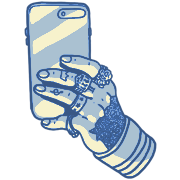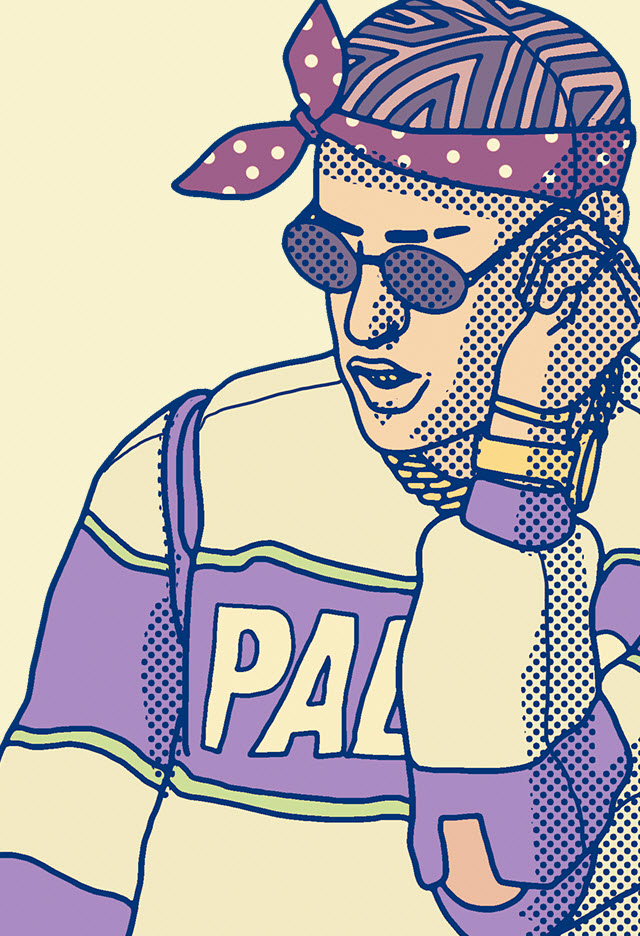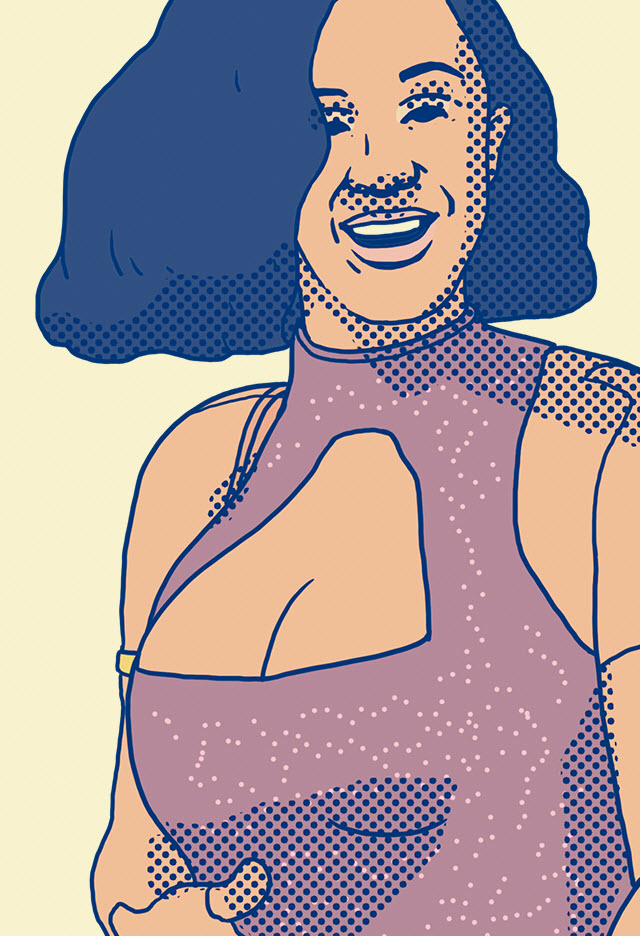
Making a Latino Superstar
In 2017, a handful of artists challenged expectations about what it means to be a Latino in the music industry. Here’s a look at the ways Latino artists marketed themselves in 2017, and the conventions they must navigate to find success.
Story: Isabelia Herrera, Julyssa Lopez, and Matthew Ismael Ruiz
Illustrations: Copete Cohete
Art Lead: Alan López
For those of us who have spent a lifetime immersed in Latino pop music, the narrative of the “Latin explosion” is all too familiar. Every couple of years, major media outlets declare that we are poised for another breakthrough, finally ready to carve a permanent place in the U.S. pop market. In 2017, “Despacito” and “Mi Gente” were the fulcrum of this conversation, global phenomena that supposedly transformed the music market into a utopia for Latino artists.
But for those of us who have followed the work of Latino artists for decades, this so-called boom is not new. In fact, it is the dominant lens through which Latin music is read. As Buzzfeed’s Pier Dominguez notes, “Latinx acts are visible only when they’re supposedly booming or crossing over.” To be sure, 2017 was a year of renewed Latino visibility in U.S. pop music – two Spanish-language songs sat in the top 10 of the Billboard Hot 100 for the first time. But the success of these hits raises essential questions about opportunities for Latino representation in pop music.
Latino art and music continues to be predicated on crossing over, and many Latino pop stars have had to rely on shared cultural signifiers to make it in the mainstream market – think about the “Latin lover” or “spicy Latina” stereotype. But in 2017, a handful of musicians positioned themselves as individuals who challenged the marketing paradigm for Latino pop stars. Together, these artists helped redefine what audiences expect Latino musicians to sound and look like, expanding the narrow conceptions of Latinidad that have limited many of their predecessors.
In this feature, we reflect on what it takes to make a Latino superstar, unpacking the narratives behind some of the most vibrant Latino talent of 2017. Only time will tell if these success stories will yield permanent shifts in the mainstream, opening up opportunities for Latino stars to shape and mediate their identities in new ways.
–Isabelia Herrera
Watch Bad Bunny explain how he broke the marketing mold below, and scroll down for profiles on Cardi B, J Balvin, and Princess Nokia.
J Balvin
When J Balvin took the stage at the Latin Grammys this year, he arrived a full-fledged star with a string of hits to perform, touting the international success most Latino artists strive for their entire careers. And to prove just how big he’s become, he pulled Steve Aoki and French Montana into a high-octane rendition of “Mi Gente” that symbolized the song’s rapid, wild ascent into the mainstream universe.
Balvin’s own rise hasn’t been rapid or wild. It’s been the long game, strategized through careful plots that paid off in 2017. Once the Latino market had anointed him as the golden boy of reggaeton, Balvin saw a chance to reach global stardom by transforming reggaeton—and himself—into a mainstream staple that could extend beyond the Latino market. “Mi Gente” is the successful outcome of Balvin’s plan, but it also illustrates how he’s mediated his identity as a Latino artist. He’s dually embraced and rejected expectations associated with Latino acts, all while building a foundation in both the Latino and mainstream markets in hopes of longevity.
“It’s been six years of hit after hit, so people can’t say [I’m] a one-hit wonder, because we’ve been building a career of success after success…We have a background of hits,” Balvin said in a recent interview with Remezcla.
Balvin followed Daddy Yankee’s footsteps into reggaeton, but his path has been decidedly different. Whereas Daddy Yankee had to introduce Anglo audiences to reggaeton for the first time, Balvin could reshape the genre, since it had already gained recognition among Anglo listeners. That Balvin is a white rapper also figured largely into his ability to move agilely in the industry; the music business has often prioritized artists with lighter features over black rappers who originated the genre, reflecting the racial disparities that run rampant in entertainment. Balvin was helped by the privilege of his physical appearance, but he also used reggaeton’s street credibility to circumvent tropes male Latino artists face. He avoided the clean-cut, leading lover stereotypes adopted by Ricky Martin and Enrique Iglesias, without quite adhering to the tough-guy image Daddy Yankee represented in the early 2000s.
Instead, Balvin took cues from hip-hop artists like Kanye and Pharrell, selling himself as a visionary and nonconformist who could fit into the broader pop culture landscape. He meticulously cultivated his look into something that codes as “cool” to young people of the Internet age. If listeners couldn’t understand his music, they could certainly identify with a look and a vibe. In 2016, he was even chosen as the first Latino ambassador for New York Fashion Week: Men’s, which suddenly placed Latinos in the domain of modern, high-end fashion and culture—something we hadn’t seen from male Latino artists before.
“I’ve always had an eye on the future — not what’s happening, but what’s going to happen,” Balvin told Remezcla.
But Balvin’s forward-thinking tendencies paid off most in music. He declared early in his career that he wanted mainstream stars to come to him and found a collaborator and kindred spirit in Pharrell. A Ventenado interview revealed that Balvin had also thought about pairing up with Justin Bieber long before “Despacito” became an inextricable part of today’s zeitgeist. From Beyoncé and Alejandro Fernandez to Romeo Santos and Drake, collaborations aren’t new in the Latino market. But Balvin’s intentions weren’t to simply achieve a list of crossover hits. He wanted to prove that he could blur market lines, and that mainstream interest in Latino pop could mean lasting success.
Even his collaborations with other Latinos reflect prescient, long-term thinking: He joined trap star Fuego for 2016’s “35 Pa Las 12,” predicting the rise of Latin trap and positioning himself in a burgeoning genre that could lead to more global attention. Compared to Latino artists who are treated like flash-in-the-pan phenomena, Balvin’s maneuvers are an attempt keep growing and progressing on the mainstream stage. Continued relevance is the ultimate goal.
“He is so smart about what to do with his career and what I like about him is that he takes risks. He doesn’t care what people think. He’s just goes for it,” Spotify’s Rocio Guerrero told Remezcla. As the streaming service’s head of Global Cultures, Guerrero watched earlier this year as Balvin launched another tactical experiment with “Mi Gente,” which became the first Spanish-language to reach no. 1 on Spotify’s global charts.
What drew him to “Mi Gente,” Balvin told Remezcla, was that the song represented a sonic democratization. The remix of French producer Willy William’s “Voodoo Song” had a universal sound, the right fit for Balvin’s global ambitions. “Mi Gente” even attracted Beyoncé, who jumped on a remix that told the world that she approved of Balvin’s stardom. Although the song is in Spanish, flourishes of EDM and moombahton make “Mi Gente” a more palatable package for international listeners.
“When you hear ‘Despacito,’ you know it’s Latin music with the guitar, and the melodies are more from this world. But when you hear ‘Mi Gente,’ you’re not totally sure where the beat is from. You don’t think, ‘Oh that’s from Colombia,’” Balvin said.
Days after “Mi Gente” dropped, Milenio.com reported Balvin saying, “I no longer make music for Latinos… I want my music to be heard by the human race.” It may have sounded like he was renouncing the audience to whom he owes his fame, but the admission actually hints at the limitations that come with being a Latino artist. Even when Latino artists cross over, their central role is seen as creating art for other Latinos. But Balvin’s insistence on transcending genres and demographics challenges the Latino artist paradigm. He tells Remezcla that his forthcoming music is “totally different from ‘Mi Gente’” and riffs on dancehall and African rhythms that aren’t typically coded as “Latino” – even though these sounds form the foundation of Latin American music.
His next step seems to be a departure from his reggaeton roots, which leaves the unanswered question of how much Balvin will tout his Latinidad in the future. Still, it’s hard to imagine a world in which he can fully escape the segmentation that accompanies the label of being a Latino artist—Balvin holds onto his identity by continuing to sing in Spanish. Even if his songs arrive in formats that sound nothing like Latin American genres, the language may continue to define how he’s categorized, complicating his evolution into a global figure. But we have to approach Balvin with some faith: He’s taught us that his calculated moves are all part of a larger design.
–Julyssa Lopez

Bad Bunny
Call them the shorts that launched a thousand jabs. When Bad Bunny premiered the video for “Tu No Vives Asi” with Arcángel in 2016, he remembers that a surprising number of viewers immediately zeroed in on a pair of white cutoffs he was wearing.
“People are so used to what’s traditional that they thought it was super weird that I had shorts on. That was a scandal for a lot of people, something as simple as shorts that everyone wears. I think the whole thing was that they went above my knee, and that seemed strange to the whole world,” he laughs now.
Now that Bad Bunny’s career has skyrocketed, it’s trivial—although still hilarious—to talk about trap en español’s most contentious shorts. But the fashion fracas is a small symbol of Bad Bunny’s quiet rebellions.
Since blowing up in Puerto Rico, Bad Bunny has stood out from the standard model of Latino artists, notably for performing trap, a genre that isn’t typically associated with Latinidad. He’s become the Latino market’s answer to the mainstream’s insurgent—and commercially viable—cadre of trap and SoundCloud rappers, embracing their outlandish antics and high-end-meets-calle aesthetic. In the process, Bad Bunny has introduced large swaths of Latino listeners to the Atlanta-bred style of rap and shaped his own image as a daring misfit who would wear those shorts—and pink coats and flowered Gucci—while making songs that jostle between the comedic and profane. His persona flips the script on the hyper-masculinity that plagues Latino stars and reimagines what a Latino rapper can look like.
The attitude helps. Bad Bunny has always acted with the conviction that people will come around and get what he’s doing eventually. And in 2017, they did. It was the year of Bad Bunny, thanks to trap en español’s growing footprint and the 23-year-old’s ability to market himself as a knowledgeable, underground trap maverick. With his thick-tongued rhymes and potent baritone, Bad Bunny oozed unruffled cool onto SoundCloud releases, like 2016’s “Diles,” which DJ Luian heard before signing Bad Bunny to his influential imprint Hear This Music last year. The move helped bolster Bad Bunny’s credibility among members of reggaeton’s old guard, such as Arcángel and De La Ghetto, while also setting him comfortably into a circle of insolent new trap artists that includes Bryant Myers and Anuel AA.
Standing at the juncture of urbano’s old and newest factions has given Bad Bunny more dexterity and opportunity in the industry. Plus, as Apple Music’s Jerry Pulles pointed out in a conversation with Remezcla, Bad Bunny emerged at the right time, just when trap en español needed a definitive figure to shine its spotlight on. Pulles had created the Apple playlist “Trap Kingz” in mid-2016, before Hear This released the remix of “Diles,” and remembers that the song fit perfectly on the playlist and in the broader landscape of the genre. “His music had a home to go to right from the start,” Pulles said.
Like mainstream SoundCloud rappers sold as unvarnished Internet phenomena, Bad Bunny wields a dangerous, somewhat nihilistic quality, which undoubtedly attracts listeners looking for provocative alternatives to traditional radio. His lyrics are unabashedly explicit, blatantly dealing in Puerto Rican social taboos in a way that is comparable to reggaeton’s early hedonistic (and misogynistic) days. But Bad Bunny also packs an added layer of wit and wry humor into rhymes filled with references to sports, hip-hop, fashion, cartoons and even the occasional chisme. (“Tú extrañas este bicho como Denise extraña el de René,” he sings on “No Te Hagas,” a dig at the tabloid romance of Calle 13’s René Pérez and former Miss Universe Denise Quiñones.) His expansive pop culture lexicon flows into content that’s refreshing, smart-alecky and sharp, especially compared to artists trumpeting stale themes and stereotypes often churned out by the industry.
In past interviews, Bad Bunny has said that his influences include Vico C and Héctor Lavoe, two lyricists who may have impacted his own writing style. Pulles notes that Bad Bunny’s rhymes are malleable and sometimes surprisingly poignant; songs like “Soy Peor,” for example, detail heartache, and could even function as ballads. This versatility offers Bad Bunny opportunities for growth and reinvention, something that remains elusive for Latino stars expected to perform—and stick to—certain identities for consumption.
“I’m always going to keep my essence as Bad Bunny—that’s what I’m trying to maintain. Even when I do reggaeton, I try to stay who I am in a reggaeton rhythm. We just did salsa track with Victor Manuelle and we did it with my flow, without sounding strange,” he said.
While trap constantly faces criticism that its content is too explicit for the mainstream, purists worry that it could lose its edge if it becomes more popular. Both directions seem to work in Bad Bunny’s favor: Although his lyrics are among the genre’s most irreverent, he’s shown he can construct more pop-inclined sounds and collaborations. Already, he’s worked with Camila Cabello, J Balvin, and Becky G, and experimented with EDM on Wisin and Timbaland’s “Move Your Body.” The question may be how Bad Bunny preserves his voice as his music continues to scale, but already a banner year in 2017 suggests he’ll be able to stay himself amid the noise.
–Julyssa Lopez

Princess Nokia
Amid a sea of generic trap rap and garden-variety misogyny, a voice like Princess Nokia stands out. A small brown woman with a huge personality, the Boricua MC is a swirl of walking, talking, and rapping contradictions. In person, she’s a bit of fashion chameleon, equally comfortable rocking 90s tomboy looks, flexing luxe designer threads on Instagram, stomping on the boardwalk in a cutout swimsuit, and embracing her inner femme in a music video.
Sonically, she can borrow staccato flows from the South (see “Excellent” from her 1992 mixtape) as skillfully as she samples the soulful spirit of her hometown of New York (“Saggy Denim”). She’s at once intensely personal and confrontational, embracing non-traditional beauty standards (“My lil titties and my fat belly,” she proudly raps on “Tomboy”), but also making questionable comments in interviews, like when she told Genius that “all your men fantasize” about her because of her “little frame and sweet little girl voice.” An activist in touch with her spirituality, she’s been a champion of the marginalized, adamant about creating spaces for QTPOC at her shows, and makes direct references to her Afro-diasporic and Taina roots, like her prideful paean “Brujas.” On it, she raps, “I’m that Black a-Rican bruja straight out from the Yoruba/And my people come from Africa diaspora, Cuba/And you mix that Arawak, that original people/I’m that Black Native American, I vanquish all evil/And my ancestors Nigerian, my grandmas was brujas.”
She’s also fiercely aggressive, known to lash out violently against offensive speech; She famously threw hot soup on a subway masochist spewing racist bile, and once allegedly struck a fan in the face for hollering sexist comments at her from the crowd.
By the time that Rough Trade signed her earlier this year, her debut mixtape 1992 had already exploded online, capitalizing on an army of young, black, brown, and queer kids who would come out in droves to her shows. In a move that mimicked its approach to Bandcamp signings Lucy Dacus and Car Seat Headrest, Beggars Group — the label conglomerate that owns Rough Trade, Princess Nokia’s label — immediately reissued a deluxe version of 1992 to capitalize on the grassroots success of hits like “Tomboy” (5M+ views) and “Brujas” (3.7M views). The relationship reflects the role labels play for ascendant artists in 2017; far from helping them develop an image or sound, their role is mainly to amplify their work, using embedded relationships and distribution channels to grow an already fervent fanbase as large and as quickly as possible.
That independence has allowed her to flourish, exploring and experimenting with her Latina identity – and all her other selves. She resists categorization, demanding we reconcile her multitudes. To say she’s unrepentant about expressing her identity is a woeful understatement. That there’s a space for her to be successful without being exploited (yet) says a lot about the way the Internet has democratized the ground floor of the music industry. The gates to the upper echelons of pop stardom are still kept by corporate major label interests, so it remains to be seen if Princess Nokia can put a dent in the Billboard charts. It wouldn’t be new for Beggars—they distribute through Warner Music’s Alternative Distribution Alliance, and their label XL broke Adele—but it would be new for a Boricua rapper, especially one with an eclectic sound that has less in common with the current trap wave than say, Cardi B. When she finally releases her next original work for Rough Trade, it will be interesting to see how her sound evolves. Will it dovetail with the mainstream, or will she continue on her own path? Because she’s already proven that if you can find your people online, there’s room to be yourself, without compromise—blemishes and all.
–Matthew Ismael Ruiz

Cardi B
Cardi B is not your formulaic pop diva. She wasn’t plucked from obscurity by a suit looking to check a box; She clawed her way from the strip club stage to the top of the pops with a wicked cackle, an infectious personality, and a laser focus on getting that “shmoney.” And for every Afro-Latina who has never seen her reflection in the upper echelon of pop music, the “Bodak Yellow” star is an avatar for big-money dreams, an honest representation of an often-ignored slice of Latinidad, one that doesn’t feel stale or postured.
Cardi B’s path to success also represents a shift in the power balance between ascendant artists and the major labels. She leveraged a loyal fanbase on social media to propel her from the strip club stage to a show-stealing turn on VH1’s Love and Hip-Hop, where she was able to gather the resources and connections to start a rap career. Sure, Atlantic was able to give her access to their traditional distribution channels, but the dynamic has changed from the pre-social media days. In 2017, it’s almost unheard of for a major to sign an artist without a huge social media following, which means they have inherently less leverage—or incentive—to try to change her style or music. Even if she was new to rapping, her fans were already on Team Cardi, and would likely respond poorly to a new, label-crafted Cardi B. The social-media mobilization that led to the chart success of “Bodak Yellow” without the benefit of any superstar guest features proves an artist like Cardi can pull the numbers the suits crave while staying true to herself.
Beyond this shift in the label dynamic, Cardi is black, unlike some of her Latino predecessors in hip-hop, a reality that affects the way she’s read by mainstream hip-hop audiences. Forebears like Fat Joe and Terror Squad drew on cultural signifiers like salsa samples and Spanish-language phrases, but Cardi has been able to largely avoid commodifying her Dominican-Trinidadian ancestry. Her lyrics make occasional overtures to Latinidad (“I’m the trap Selena/Dame más gasolina” from “Motor Sport”), but she’s so far managed to avoid being tokenized—most likely because of her identity as a black Latina.
Fat Joe rarely raps in Spanish, and while West Coast legends Cypress Hill released a Greatest Hits record in Spanish, it was well after the peak of their relevance. But Cardi B shatters the notion that Latinidad should—or can—be narrowly defined, that the only way for a Latino artist to be successful is to hawk milquetoast dembow and guitar pop en español. As evidence, she dropped the Latin trap remix of “Bodak Yellow,” a collaboration with Messiah shouting out her come up from the Bronx (“Tu chapeando/yo llegando/y cobrando/siempre ‘toy depositando/’tan cansá de mi en el banco”), and recently hooked up with Dominirican heartthrob Ozuna for some Spanish singing on “La Modelo.” It’s incredibly rare for a Billboard No. 1 artist to rap in both Spanish and English, and it’s allowed Cardi to bridge the gap between different parts of her fanbase on Instagram, exposing her non-Latino fans to trap en español and reggaeton.
As a gatekeeper with a foot in multiple worlds, the fact that she’s able to explore all sides of herself in this universe points to changing barriers in the hip-hop world. It might show there’s more opportunity for Latinos to express their musical identities in complex ways. While the grassroots model requires an artist to develop their fan base before they get a major label deal, it also means that stars are now organically grown from online communities, not manufactured by a suit in a skyscraper. And it might help pop’s current obsession with Latino sounds into the start of something sustainable. If it does, Cardi won’t have to do anything but be herself to take advantage.
–Matthew Ismael Ruiz

As the music landscape evolves in 2018, aspiring Latino pop stars might need to turn to new strategies for reinvention. Sure, the Latin remix – wherein Anglo artists hop on a Spanish-language track, or vice versa – yields megahits, but at a time when attention spans run short, relying on the name recognition of established stars won’t necessarily ensure enduring U.S. pop careers. Alejandro Duque, the general manager of Universal Music Latino, explains, “These remixes with non-Latino artists have been proven to work but still need to be organic and many different efforts need to align to make it a global hit…always recurring to this can start to seem like a gimmick.”
Instead, Latino pop stars need to make more mature, risky artistic choices, perhaps in the form of multilingual and cross-genre collaborative albums. As the tight grip of major labels and terrestrial radio loosens in the music industry, and the influence of traditional gatekeepers erodes, new opportunities for Latinos to experiment with their identities may follow.
In this increasingly complex global music moment, Latino artists’ success continues to be dictated by marketing conventions tied to their identities. And as more watershed moments of representation flood our timelines in 2018, examining how these discourses shape the way Latinos are understood is essential.
We remain a community of difference, defined by our intersections. More representation in pop music won’t save us from racism, commodification, or inequality, but it may offer us the space for artistic exploration and experimentation we are rarely afforded.
–Isabelia Herrera








